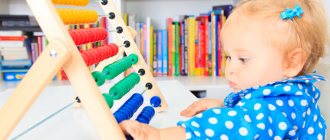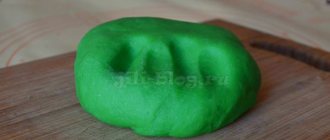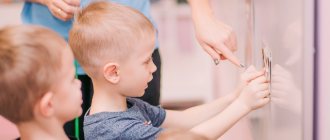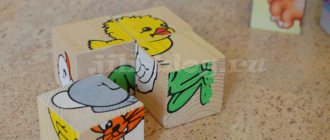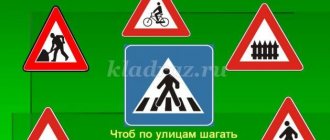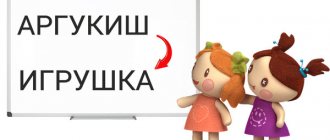Games and exercises for developing fine motor skills
Bochkareva Natalya Petrovna, teacher of the preschool department “Golden Fish”, Secondary School No. 15, Neftekamsk, village. Power engineer as part of the second stage of the pedagogical marathon “The World of Preschool Children is My World.”
“The origins of children’s abilities and gifts are at their fingertips” V.A. Sukhomlinsky
At 3-4 years old we use all fingers.
Finger theater is an exciting didactic game that:
1. stimulates the development of fine motor skills;
2. introduces the child to such concepts as shape, color, size;
3. helps develop spatial perception (concepts: right, left, next to each other, who is in front, etc.);
Advertising message
4. develops imagination, memory, thinking, attention, speech.
5. helps develop vocabulary and activates speech functions;
For inept children's fingers, such a toy will be very useful - a button-fastening simulator.
Lacing games:
1. develop sensorimotor coordination and fine motor skills of the hands;
2. develop spatial orientation, contribute to the assimilation of the concepts “above”, “below”, “right”, “left”;
3. develop lacing skills (lacing, tying a lace into a bow);
4. promote speech development;
5. develop creative abilities;
6. develop perseverance;
We can say that the lace is a snake; it likes to crawl around the house (crawl through holes). When a child pulls a lace through the holes, pay the child’s attention to the location of the lace on the “house” - at the top or bottom, on the right or left, in the center. Tell where the snake wants to crawl, let the baby help it.
Games with cereals, seeds, sticks.
Cereals are a universal material. You can just tinker with it or create a real masterpiece.
Take a tray and scatter small grains (for example, semolina) on it. You can't imagine a better drawing board. First, the adult draws lines on the “board”, and the child repeats. Let these be very simple shapes: squares, circles, zigzags. Snowman, house, sun.
Pour dry peas into a mug. The child transfers the peas one by one to another mug. First with one hand, then with both hands at the same time, alternately with the thumb and middle finger, thumb and ring finger, thumb and little finger.
Place the beans on a saucer. The child takes the bean with his thumb and forefinger and holds it with the other fingers (as when picking berries), then takes the next bean, then another and another - so he picks up a whole handful. You can do this with one or two hands.
You can use sticks to make images of objects.
Bags of cereal are exercises for the development of tactile sensitivity and complexly coordinated movements of the fingers and hands.
· develop fine motor skills;
develop attention; speech;
· develop memory (after all, you need to remember which pouch has already been examined so as not to touch it twice.)
Naturally, the younger the child, the fewer pouches he will have to examine. You can combine the game with loops and hooks with the game “Magic Bag”. To do this, you will need several small cloth bags of the same size. Place a small toy or object in each bag. And hang it all on hooks. Name the child the object he has to find. Offer to remove the bags from the hooks one by one and feel the object without removing or opening the bag. If the bag does not contain what you need, you need to hang it up and move on to the next bag.
Exercises with clothespins
The purpose of the exercise is to teach the child to attach clothespins independently. To make the game interesting for a child, you can attach clothespins according to the theme (that is, rays to the sun, needles to a hedgehog, rain to a cloud, grass to the ground, and the like; for this you need, accordingly, to make preparations for the sun, hedgehog, and so on ).
Exercises with beads.
Various stringing exercises are excellent for developing the hand. You can string anything that can be strung: buttons, beads, horns and pasta, dryers, etc. You can make beads from cardboard circles, squares, hearts, tree leaves, including dry rowan berries. Learning how to pierce neat holes is also useful. The size of the beads depends on the age of the child. First, instead of beads, you can use balls from pyramids with round parts and string them on a thick cord; then the parts need to be gradually “crushed”
Laying out figures using beads.
For the exercise, medium-sized beads already strung are used. The purpose of the exercise is to teach the child to lay out the outlines of objects, a heart, a spiral, etc. from beads, while talking with the child.
Productive activity.
In addition to games and exercises, various types of productive activities (drawing, modeling, appliqué, design, etc.) also contribute to the development of speech. All these types of productive activities unobtrusively help children communicate in a group. Review and evaluate the work of your friends.
Exercises with paints.
Some teachers and psychologists offer exercises with paints to develop motor skills. They consist in the fact that the child dips his finger in watercolor or gouache paint, and then applies his “drawing” to a sheet of paper. These exercises can be done from 2 years of age.
Games with construction sets and mosaics - at this time, not only imaginative thinking develops, but also imagination and fine motor skills. The child tells what he did and shows everyone.
Rearrange the toys.
Goal : Learn to grasp small objects with a pinch, develop coordination actions of both hands.
Equipment. Small objects (chips, buttons, mosaic, tall vessel).
Progress of the game.
The teacher shows fingers folded in a pinch. He takes small objects and throws them into the vessel, drawing the children’s attention to the fact that he is holding the vessel with his other hand. Invites the children to do the same. Hearing an adult, the child repeats and expands his vocabulary of words in speech.
The doll came from a walk.
Purpose: To teach children to unfasten buttons; continue to develop fine hand movements; to generate interest in mastering object-based game actions by asking children questions.
Equipment. Doll. Clothing to go with it (buttoned sweaters, coats).
Progress of the game.
A doll comes to the children and asks them to help her undress, because she does not know how to unfasten buttons. Children are asked to help the doll. The teacher names the words of clothing, and the children repeat.
Games are played in a similar way: “Let’s dress the doll for a walk” - children fasten the buttons. “Let’s put the doll to sleep” - children unbutton smaller buttons on the dolls’ clothes: (sundresses, blouses, vests).
Help Dunno.
Goal: To teach children to fasten buttons, develop small hand movements, form a positive attitude towards the game, developing the child’s speech.
Progress of the game . The teacher shows Dunno and says that he wants to collect a flower from the petals, but he doesn’t know how, he needs to help him. Then he explains to the children how to sequentially put loops of petals on buttons and distribute them around the button to create a beautiful flower. Dunno rejoices and thanks the children.
Puzzles are colorful pictures of the world around us.
The game develops attentiveness, intelligence, speech,
coordination of the work of the eyes and hands.
Games with sensory mats.
Goal: To teach children to fasten fasteners, developing speech.
Vocabulary work is closely related to the child’s familiarization with the world of things, phenomena, their properties and qualities. From object to word and from word to object are two interrelated approaches.
Laying out the mosaic.
Goal: To teach children to grasp with a pinch, to develop attention, speech, imitation, the ability to analyze and produce a simple sample.
Material: mosaic, small story toys - nesting dolls, dolls, bunnies.
Progress of the game. The teacher shows the children the mosaic board and draws the children's attention to the holes. He takes one mosaic element and together with the child examines the hat and pin. Shows how to insert the mold into the hole hole. Teaches you how to take shape with a pinch. Children lay out paths for matryoshka dolls.
By folding your fingers in a certain way, you can get images of different objects, animals, birds.
Bunnies. The little finger and ring finger are bent and held with the thumb - the muzzle, and the other 2 fingers rise up - the ears.
Geese. Press 4 fingers together and press your thumb underneath them.
Snail . One hand is clenched into a fist, and the other is under the fist with the index and middle fingers extended.
Glasses. The thumb and index fingers together form rings, straighten the remaining fingers.
The grandmother put on her glasses and her granddaughter saw them.
Checkbox. Four fingers (index, middle, ring and little fingers) together, thumb down. Back of the hand towards you.
The flag is burning in the sun, as if I had lit a fire.
Boat. Both palms are placed on the edge, the thumbs are pressed to the palm.
The boat floats along the river, leaving rings on the water.
Christmas tree . The fingers are passed between each other, palms at an angle to each other.
Cat . The middle and ring fingers rest against the thumb. Raise your index and little fingers up. And the cat has ears on the top of her head so that she can better hear the mouse in her hole.
The game “Catch a Fish ” promotes the development of flexor and extensor movements of the hands in children.
Progress of the game.
Children catch fish and take them to the aquarium.
Game "Make a whole toy."
Goal: To teach children to fasten buttons while developing speech.
Progress of the game.
The teacher shows a figurine of a bear. He examines it with the children, paying attention to individual parts: head, torso, paws. Explains that the head is at the top, the body is at the bottom, and the paws are on the sides. Then the teacher shows how to make a bear, composing it from parts. First, all the parts are placed on the table, then all the buttons are fastened, connecting all the parts together. They invite the children to make the same bears.
Application "Ornament".
Goal: To teach children to perceive and reproduce the relative positions of geometric shapes on a plane, taking into account color and shape.
Material: sample ornament (green square in the center, red circles in the corners). Handout: sheets of paper with a contour image of the same ornament: 4 red and 4 green circles cut out of cardboard; 4 red and 4 green squares.
Management . Children, look how beautiful our napkin is. That's right, the square is green. What is her figure in the middle?
This napkin also has decorations in the corners. What figures are glued in the corners? That's right, these are circles, red circles. Then the teacher invites the children to decorate their napkins.
“You have a lot of different figures. Choose different figures and arrange them on napkins just like this one. When you're done, leave your napkins on the tables.
To form a vocabulary for children, a variety of demonstration materials are used:
Toys, objects, pictures, tabletop theater figurines, bi-ba-bo dolls, waste material - corks, flannelgraph with illustrations.
An object is shown and called (Children look at and name what they see.)
Finger games, physical minutes and tasks are used.
New words are repeated many times individually and in chorus, which helps to enrich the vocabulary of words in children.
Questions are asked to the children: “What do you see? Which subject? Who do you see in the picture? What are they doing?"
Orders are used (Find, bring.)
The ability to correctly use intonation means of expressive speech when pronouncing tongue twisters is developed. Speak loudly, quietly, quickly, slowly).
Working with pictures, children sort through them, name them, and expand their vocabulary.
Through play, the emotional life of children becomes richer and more diverse, creativity develops, and all this increases speech activity.
Thus, as a result of the work done, I came to the conclusion that purposeful, systematic and planned work on the development of fine motor skills in preschool children contributes to the formation of speech.
Did you like the article?
Vote for Natalya Petrovna’s work - press the social network buttons, write comments!
You can view the works of the marathon participants HERE.
Middle group. Junior preschool age. Children 4 - 5 years old
Master class for parents “Development of fine motor skills of the hands in children 4–5 years old with disabilities” Purpose: to acquaint parents of children of middle preschool age with the influence of fine motor skills of the fingers on the development of children’s speech. Objectives: to give parents a basic understanding of fine motor skills ; replenish parents’ knowledge about the development of fine motor skills of children’s hands at home...
Notes of SOD with children of primary preschool age on finger painting “Berries for a hedgehog” SYNOPSIS OF JOINT EDUCATIONAL ACTIVITIES WITH CHILDREN OF PRIMARY PRESCHOOL AGE ON THE IMPLEMENTATION OF THE EDUCATIONAL FIELD ARTISTIC AND AESTHETIC DEVELOPMENT “BERRIES FOR A HEDGEHOG”
.
(using gaming technologies)
Purpose: to consolidate the skill of drawing with paints in a way ...
Card index of games for sensory development in kindergarten
It is important for a child to learn to develop an understanding that even objects of the same shape and color can differ from each other in texture and be different to the touch. This can be achieved by using plasticine, salt dough, felt, wool for felting, various buttons, beads, sticks, as well as a variety of materials.
Note! Activities with bulk toys, working with different types of paper, and playing with strings fit perfectly into the sensory development program.
